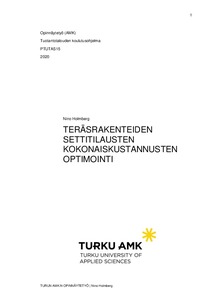Teräsrakenteiden settitilausten kokonaiskustannusten optimointi
Holmberg, Nino (2020)
Holmberg, Nino
2020
All rights reserved. This publication is copyrighted. You may download, display and print it for Your own personal use. Commercial use is prohibited.
Julkaisun pysyvä osoite on
https://urn.fi/URN:NBN:fi:amk-2020061819089
https://urn.fi/URN:NBN:fi:amk-2020061819089
Tiivistelmä
Tässä opinnäytetyössä selvitettiin yrityksen mahdollisuutta saavuttaa kustannussäästöjä yhden konemallin settitilausten osalta. Nykyistä menetelmää ja sen kustannuksia verrattiin vaihtoehtoisiin toimittajiin, sekä vaihtoehtoisiin logistisiin ratkaisuihin. Kustannusten lisäksi yrityksellä oli myös muita tekijöitä, jotka vaikuttivat lopulliseen valintaan. Näiden avulla selvitettiin yritykselle kannattavin ratkaisu. Tavoitteena oli tehdä laskelmista monistettavia myös muille konemalleille tulevaisuutta varten.
Opinnäytetyön teoriaosuudessa tarkasteltiin miten kokonaiskustannukset rakentuvat. Tässä tutkimuksessa huomioitiin kustannuksiin perustuvien tekijöiden lisäksi myös laadullisiin tekijöihin perustuvia tekijöitä. Yhdessä nämä tekijät muodostivat kattavan kokonaisuuden, joiden pohjalta pystyttiin rakentamaan toimiva kokonaiskustannusmalli.
Työn tutkimusosassa yrityksen eri vaihtoehtoja vertailtiin eri tavoin. Jotta niitä voitiin vertailla tasapuolisesti, huomioitiin eri vaihtoehtojen kohdalla kustannuksiin- ja laadullisiin tekijöihin perustuvia tekijöitä, sekä niiden SWOT-analyysejä.
Tuloksena tutkimuksesta saatiin riittävä määrä informaatiota, jotta yritys pystyi tekemään suuntaa antavan päätöksen toimittajan ja logistisen ratkaisun suhteen kokonaiskustannusten osalta. Yritys pystyi hyödyntämään tutkimuksessa käytettyjä laskelmia myös muiden konemallien osalta. The main objective for this thesis was to find out if it was possible to achieve savings in set deliveries for one of the company’s products. Their current method and its total costs were compared to alternative suppliers and to alternative logistic solutions. The company also had other influential authors that effected the final decision. To arrive at the best option/method/solution for the company, both the different influential authors and the total costs were considered. The second objective for this thesis was to make the calculations duplicatable for the company’s future needs.
In the theory part of this thesis the structure of total cost of ownership was examined. Both costs and quality-based costs were considered. Together these authors formed a comprehensive entirety. A functional model of total costs was made based on the authors.
In the research part of this thesis different options for the company were compared in different ways. Both costs and quality-based costs were considered, as well as the SWOT-analyses of each considered option to make an equal comparison.
As a result of the thesis, the company got enough information to determine which supplier and logistic solution was most suitable from total cost of ownership point of view. The company was able to use the calculations used in the thesis for other similar products.
Opinnäytetyön teoriaosuudessa tarkasteltiin miten kokonaiskustannukset rakentuvat. Tässä tutkimuksessa huomioitiin kustannuksiin perustuvien tekijöiden lisäksi myös laadullisiin tekijöihin perustuvia tekijöitä. Yhdessä nämä tekijät muodostivat kattavan kokonaisuuden, joiden pohjalta pystyttiin rakentamaan toimiva kokonaiskustannusmalli.
Työn tutkimusosassa yrityksen eri vaihtoehtoja vertailtiin eri tavoin. Jotta niitä voitiin vertailla tasapuolisesti, huomioitiin eri vaihtoehtojen kohdalla kustannuksiin- ja laadullisiin tekijöihin perustuvia tekijöitä, sekä niiden SWOT-analyysejä.
Tuloksena tutkimuksesta saatiin riittävä määrä informaatiota, jotta yritys pystyi tekemään suuntaa antavan päätöksen toimittajan ja logistisen ratkaisun suhteen kokonaiskustannusten osalta. Yritys pystyi hyödyntämään tutkimuksessa käytettyjä laskelmia myös muiden konemallien osalta.
In the theory part of this thesis the structure of total cost of ownership was examined. Both costs and quality-based costs were considered. Together these authors formed a comprehensive entirety. A functional model of total costs was made based on the authors.
In the research part of this thesis different options for the company were compared in different ways. Both costs and quality-based costs were considered, as well as the SWOT-analyses of each considered option to make an equal comparison.
As a result of the thesis, the company got enough information to determine which supplier and logistic solution was most suitable from total cost of ownership point of view. The company was able to use the calculations used in the thesis for other similar products.
